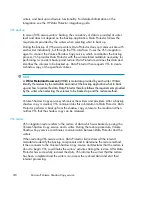
Instant recovery
During snapshot backup sessions, several snapshot copies of data can be produced
and can be retained on a disk array, each point-in-time copy in its own replica. The
retained snapshot copies of data can then be used for various purposes, such as
offline data processing or instant recovery. Only the point-in-time copies produced
during ZDB-to-disk and ZDB-to-disk+tape sessions can be restored using the instant
recovery functionality.
Using the instant recovery functionality, the point-in-time copy from a selected replica
is restored within a disk array and returned to its state at the point in time that the
snapshot data was produced. This process does not involve any restore of data from
tape media, dramatically reducing the overall restore time.
Application archive log files are not included in snapshot backup, therefore to restore
and apply them, they need to be restored from tape media.
Replica set and replica set rotation
The maximum number of replicas that can be kept concurrently on a disk array is
dependant on the disk array used. The replicas kept on the disk array for the same
backup specification form the
replica set
for that backup specification. The replica
set is defined by the maximum number of replicas that are to be kept on a disk array
for a particular backup specification. When during a snapshot backup session, this
number is reached, the snapshot data in the oldest replica in the replica set is
overwritten; if the number is not reached yet, a new replica is created - these two
actions are referred to as
replica set rotation
.
Types of snapshots
Depending on a disk array used, different types of snapshots can be created during
a Data Protector snapshot backup session. The Data Protector snapshot integrations
utilize the following types of snapshots:
•
copy-on-write snapshots with the preallocation of disk space
•
copy-on-write snapshots without the preallocation of disk space
•
snapclones
Snapshots with the preallocation of disk space
The creation of copy-on-write snapshots with the preallocation of disk space requires
the same amount of disk capacity to be allocated as for the source volume. Data is
Concepts guide
279
Содержание B6960-96035
Страница 17: ...Overview of backup and automated media copy sessions 340 105 Concepts guide 17 ...
Страница 20: ...20 ...
Страница 22: ...Publication history 22 ...
Страница 132: ...Planning your backup strategy 132 ...
Страница 182: ...Media management and devices 182 ...
Страница 186: ...Users and user groups 186 ...
Страница 204: ...The Data Protector internal database 204 ...
Страница 218: ...Figure 62 Direct SIP integration example Service management 218 ...
Страница 242: ...Integration with database applications 242 ...
Страница 264: ...Synthetic backup 264 ...
Страница 274: ...Split mirror concepts 274 ...
Страница 288: ...Snapshot concepts 288 ...
Страница 344: ...Further information 344 ...
Страница 402: ...Glossary 402 ...
















































